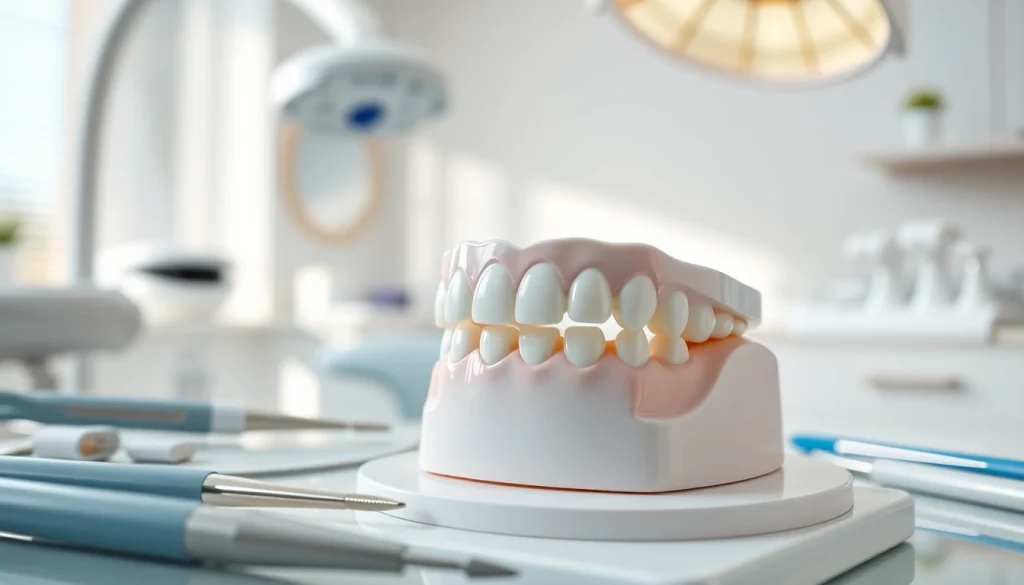
1. What are Dental Bridges?
1.1 Definition and Purpose of Bridges
Dental bridges are a common restorative dental solution designed to replace missing teeth, bridging the gap between one or more deficient teeth. A dental bridge typically consists of one or more artificial teeth (pontics) anchored to adjacent natural teeth or dental implants, providing functional restoration and aesthetic improvement to a patient’s smile.
The main purpose of dental bridges is to restore the natural appearance and functionality of a person’s teeth, allowing them to chew properly, speak clearly, and maintain facial aesthetics. Missing teeth can lead to numerous complications, including shifting teeth, jaw misalignment, and difficulties with eating or speaking, making bridges an essential consideration in restorative dentistry. For more information on dental solutions like bridges, you can visit bridges.
1.2 Types of Dental Bridges
There are several types of dental bridges, each serving different needs and preferences:
- Traditional Bridges: The most commonly used type, these consist of one or more crowns anchored to the adjacent natural teeth. They are suitable when the neighboring teeth are healthy and intact.
- Cantilever Bridges: Used when there are adjacent teeth on only one side of the gap, these bridges rely on one or more supporting teeth to hold the artificial tooth in place.
- Maryland Bridges (Resin-Bonded Bridges): These consist of a metal framework with artificial teeth attached, which are bonded onto the back of adjacent teeth. This type is less invasive as it requires minimal alteration of the abutment teeth.
- Implant-Supported Bridges: When three or more teeth are missing, this type of bridge uses dental implants placed in the jawbone to support the bridge, offering enhanced stability and longevity.
1.3 Benefits of Using Bridges
Dental bridges offer numerous benefits, making them a highly effective solution for tooth replacement:
- Restoration of Functionality: Bridges restore the ability to chew and speak effectively, which can be significantly hindered by missing teeth.
- Aesthetic Enhancement: Bridges improve the appearance of a smile, filling in gaps and promoting dental harmony.
- Preventing Tooth Shifting: By filling the gap left by missing teeth, bridges help maintain the alignment of neighboring teeth and prevent further complications.
- Durable and Long-Lasting: With proper care, dental bridges can last many years, making them a cost-effective solution for tooth loss.
2. The Process of Getting a Dental Bridge
2.1 Initial Consultation and Assessment
The journey to obtaining a dental bridge begins with an initial consultation where a dentist assesses the patient’s oral health. This assessment may include a thorough examination of the mouth, X-rays to evaluate bone density and health, and a discussion of treatment options tailored to the patient’s specific needs. The dentist will also review the patient’s dental history and any relevant medical conditions to determine the best approach to treatment.
2.2 Preparation of Teeth for Bridge Placement
Once a treatment plan is agreed upon, the next step involves preparing the teeth that will support the bridge (the abutment teeth). This preparation may require reshaping the adjacent teeth to allow for the placement of crowns that will hold the bridge securely in place. Additionally, impressions of the teeth will be taken to create a custom bridge that fits seamlessly within the mouth.
2.3 Finalizing and Fitting the Bridge
After the dental bridge is created, usually in a dental laboratory, the patient will return for a fitting appointment. During this visit, the dentist will place the bridge in the mouth to ensure a proper fit and make any necessary adjustments. Once satisfied, the bridge will be permanently cemented to the abutment teeth, completing the restoration process.
3. Caring for Your Dental Bridges
3.1 Daily Oral Hygiene Tips
Maintaining proper oral hygiene is essential for ensuring the longevity of dental bridges. Patients should brush their teeth at least twice a day and floss daily, paying extra attention to the area where the bridge meets the gum line. Special flossers or interdental brushes can be helpful for cleaning around and under the bridge effectively.
3.2 Regular Dental Visits for Maintenance
Regular dental check-ups are vital for monitoring the condition of the bridge and surrounding teeth. Dentists can provide professional cleanings, assess any wear and tear, and address potential issues before they become serious. Performing regular check-ups every six months is generally recommended.
3.3 Troubleshooting Common Issues with Bridges
Common issues that may arise with dental bridges include discomfort, loosening, or visible wear. If any signs of complications arise, it is crucial to consult a dentist promptly. Solutions may include adjusting the bridge, repositioning, or even replacement in more severe cases, ensuring a continued return to optimal dental health.
4. Comparing Bridges with Other Dental Solutions
4.1 Bridges vs. Dental Implants
While both dental bridges and implants serve similar purposes in replacing missing teeth, they differ significantly in terms of the procedure and long-term implications. Dental implants involve surgically inserting a titanium post into the jawbone to serve as a root for replacement teeth, offering a more permanent solution. Meanwhile, bridges require the alteration of adjacent healthy teeth and may need replacement sooner than implants, typically lasting 5-15 years under optimal conditions.
4.2 Bridges vs. Dentures
Dentures are removable prosthetic devices used to replace multiple missing teeth and are a viable option for patients missing all or several teeth. While bridges provide a more stable, fixed solution, dentures can require more maintenance, including regular cleaning and adjustments. Patients may prefer bridges for their natural feel since they do not rely on adhesives.
4.3 Cost Considerations and Longevity
When considering costs, dental bridges tend to be less expensive upfront compared to implants; however, the longevity of implants often offsets higher initial costs. Bridges may need to be replaced more frequently, depending on oral hygiene and maintenance habits, leading patients to weigh their options based on finances and long-term health benefits.
5. Real Patient Experiences and Testimonials
5.1 Case Studies of Successful Bridge Treatments
Numerous case studies highlight the successful outcomes of dental bridge treatments. For example, a patient with multiple missing teeth opted for a fixed bridge to restore their smile. Post-treatment feedback demonstrated significant improvement in chewing efficiency and aesthetics, enhancing their overall confidence.
5.2 Common Concerns and FAQs
Patients frequently express concerns about the longevity and maintenance of dental bridges. Common questions include, ‘How long will my bridge last?’ and ‘Will it feel natural?’ On average, dental bridges last about 10 years with proper care, and many patients report that once accustomed, bridges feel very natural in function and appearance.
5.3 Expert Opinions and Recommendations
Dental professionals recommend thorough consultations to assess individual needs and conditions before proceeding with any restorative treatment. Emphasis is placed on personalized care and consideration of various options, such as dental bridges, implants, or dentures, to ensure optimal results tailored to each patient’s lifestyle and expectations.






